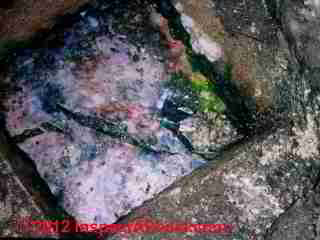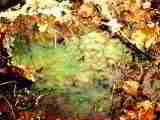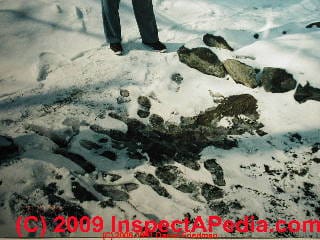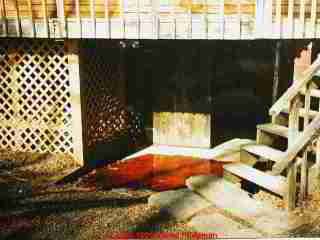 How to Spot Septic Dye Breakout Outside
How to Spot Septic Dye Breakout Outside
Where Septic Dye is Likely to Show Up During a Septic Dye Test
- POST a QUESTION or COMMENT about septic loading and dye test procedures: how to spot septic dye breakouts
Septic test dye breakout locations: this article describes where you will be most likely to find septic dye outside when conducting a septic loading and dye test - if the system is failing, here's where you're likely to see the dyed effluent appearing.
A visual inspection of these locations before and after a septic dye test is performed can give key information about the condition of the septic system. You should look everywhere on and around a site being tested but here are the most-likely locations of dyed effluent or un-dyed effluent appearance at a property with a failing septic system.
InspectAPedia tolerates no conflicts of interest. We have no relationship with advertisers, products, or services discussed at this website.
- Daniel Friedman, Publisher/Editor/Author - See WHO ARE WE?
How to Spot Septic Dye Test Breakouts: Where Will You Most Probably Find Dyed Septic Effluent Outside
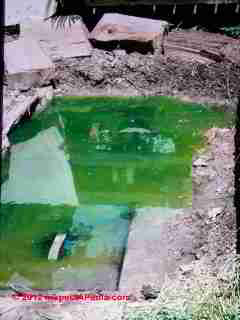 A septic effluent "breakout" is the visible movement of septic effluent to the surface of a property.
A septic effluent "breakout" is the visible movement of septic effluent to the surface of a property.
Septic effluent may appear as an area of wet soil or as an actual puddle of liquid on the ground surface.
[Click to enlarge any image]
It may also appear as dyed effluent flowing into a stream, lake, or other waterway. Septic effluent appearing on the surface of a property or in nearby ponds or streams, is incontrovertible evidence of a failure in the septic system.
Breakouts of septic effluent may occur during normal system usage when the absorption bed has failed, when the system has been overloaded, or during a septic loading and dye test.
As our photo illustrates with green septic dye, don't assume that because a septic tank is new, or has been "repaired" or "serviced" that the system is functional. This one was totally blocked, sending the test water and dye to the surface right at the septic tank.
Septic dye may appear in the septic tank right at the tank inlet, as shown in our photo (left). Here the dye was concentrated, largely because it was having trouble pushing its way into the septic tank.
Steve Vermilye, a New York home inspector, was watching a dye test such as shown at left and observed his dye disappearing as it entered the septic tank - someone had "primed" the tank with bleach, hoping to avoid discovery of a failed drainfield or perhaps over-shocking a well in hope of avoiding a failed well water bacteria test.
See CHEATING ON WATER TESTS
Dyed Septic effluent breaking to the surface may be pale red or green depending on the dye color used. Whether a septic loading and dye test is performed with or without tracer dye, effluent may appear under various circumstances.
For example, if the septic system has been pre-loaded with bleach, septic dye may not appear in the effluent. This occurs if someone has shocked the well or perhaps attempted to sabotage a septic test. It would also occur if the inspector attempted to use septic dye on a septic treatment system which injects chlorine into discharged effluent.
Before a system is tested using a loading and dye procedure, the inspector should attempt to determine the type of septic system installed. In very dilute conditions septic dye can also be detected using a "black light" (UV) if you inspect in dark or low light conditions and use a portable light source. (I have never seen anyone take this step.
Green versus red tracer dye: which is better
Green septic tracing dye works well if using a black light to check for dilute dye in waterways and on snow covered ground, or on many other colored surfaces, even dried leaves, as you can see at below left. Lots of inspectors prefer green Pylam dye because it costs less than the red.
Red septic tracing dye works best if you're looking for dyed effluent breakout in green grassy areas where the red will be easier to see.
Look for Effluent or Dyed Effluent Breakout before, during, and after the septic loading and dye test. In the photo shown here, green septic dye is quite visible in this wet area among leaves.
[Click to enlarge any image]
At Christmas and other holidays and when there is snow cover, we like to use alternating red and green septic tracer dye.
Septic Tracer Dye Appearing in Snow Covered Areas
Watch out: in deep snow cover and under solid frozen ice you may never spot the tracer dye even though the septic tank is leaking or the drainfield is in failure. While often an active septic tank and drainfield are warm enough to melt areas of light snowfall, deep snow or thick frozen snow and ice may form a cover that obscures test results.
Septic Inspection tip for snow-cover: we have more than once disclosed septic dye on the ground surface beneath deep snow cover that was not frozen solid by walking a test grid pattern across areas of possible septic drainfield location, kicking a path through soft snow at intervals frequent enough to give a good chance of showing up wet spots or tracer dye.
At below left the photo shows red septic dye appearing in a worn area of a grassy yard. More dramatic red dye appearance was shown in the basement walkout septic dye photo at the top of this page. But especially at below left you might want to know that the pink septic dye was not evident until we walked over this mushy snow covered area, compressing the snow or kicking it aside.
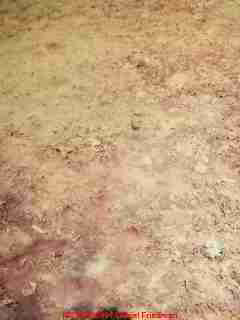
If there is snow cover, (above) walk a test grid pattern around the inspection area, scuffing to the ground surface. If there is dyed effluent breakout your scuffing in the snow will kick up green or red snow from the underside of the snow layer.
If there is frozen snow cover and the ground surface is not accessible the loading and dye test effectiveness is reduced but not eliminated.
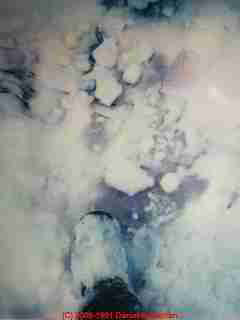
We have produced wet areas, sags in snow cover, and even stained snow and ice with this procedure.
Here is another photo of septic dye showing up in snow-cover at a property, demonstrating that dye breakout and septic failure can often be demonstrated even in winter weather.
Does the septic dye always show up outdoors?
No. Or the tracer dye may show up hours later in a nearby stream, lake, waterway or wet area.
Don't forget to also look for clear, un-dyed effluent that may still indicate a septic failure even if dye has not appeared.
Non-dyed effluent may also appear during a septic loading and dye test so be alert for any increase in the size of previously-found wet areas or for the production of new wet areas or puddles or odors.
Non-dyed septic effluent may appear due to dilution, to the presence of bleach in the system, by delays in the infiltration rate of septic effluent to the wet area you are examining, or by extended soil filtration combined with dilution of pre-existing water in the leaching area.
Inspection tip: a UV light or black light may still show up very dilute septic tracer dye in surface waters. See BLACK LIGHT & UV LIGHT USES
Watch out: Any probing of wet or suspect areas should be performed carefully to avoid any charge of damaging piping. Probing can be useful in a suspect area, but since the exact location, depth, design of buried components is unknown, this is not a reliable comprehensive inspection method.
Avoid using heavy steel wrecking bars or similar probing tools which can damage septic tank top or other components.
These pages are part of our SEPTIC DYE TEST PROCEDURE for testing septic system function. Technical review by industry experts has been performed and is ongoing - reviewers are listed atReferences or Citations . Comments and suggestions for content are welcome.
Septic System Testing Articles
- SEPTIC & CESSPOOL SAFETY
- SEPTIC COMPONENT LOCATIONS
- SEPTIC INSPECTION & TEST LAWS & PROCEDURES
- SEPTIC LOADING & DYE TEST PROCEDURE - home
- SEPTIC SYSTEM BASICS
- SEPTIC SYSTEM INSPECTION CLASS
- SEPTIC SYSTEM INSPECTION & TEST GUIDE - home
...
Continue reading at SEPTIC DYE TEST REPORT or select a topic from the closely-related articles below, or see the complete ARTICLE INDEX.
Suggested citation for this web page
SPOTTING SEPTIC DYE BREAKOUTS at InspectApedia.com - online encyclopedia of building & environmental inspection, testing, diagnosis, repair, & problem prevention advice.
Or see this
INDEX to RELATED ARTICLES: ARTICLE INDEX to SEPTIC SYSTEMS
Or use the SEARCH BOX found below to Ask a Question or Search InspectApedia
Ask a Question or Search InspectApedia
Questions & answers or comments about septic loading and dye test procedures: how to spot septic dye breakouts
Try the search box just below, or if you prefer, post a question or comment in the Comments box below and we will respond promptly.
Search the InspectApedia website
Note: appearance of your Comment below may be delayed: if your comment contains an image, photograph, web link, or text that looks to the software as if it might be a web link, your posting will appear after it has been approved by a moderator. Apologies for the delay.
Only one image can be added per comment but you can post as many comments, and therefore images, as you like.
You will not receive a notification when a response to your question has been posted.
Please bookmark this page to make it easy for you to check back for our response.
IF above you see "Comment Form is loading comments..." then COMMENT BOX - countable.ca / bawkbox.com IS NOT WORKING.
In any case you are welcome to send an email directly to us at InspectApedia.com at editor@inspectApedia.com
We'll reply to you directly. Please help us help you by noting, in your email, the URL of the InspectApedia page where you wanted to comment.
Citations & References
In addition to any citations in the article above, a full list is available on request.
- New York State Department of Health, APPENDIX 75-A WASTEWATER TREATMENT STANDARDS - INDIVIDUAL HOUSEHOLD SYSTEMS , [PDF] New York State Department of Health, 3 February 2010, retrieved 3/1/2010, original source: https://www.health.ny.gov/regulations/nycrr/title_10/part_75/appendix_75-a.htm
- Mark Cramer Inspection Services Mark Cramer, Tampa Florida, Mr. Cramer is a past president of ASHI, the American Society of Home Inspectors and is a Florida home inspector and home inspection educator. Mr. Cramer serves on the ASHI Home Inspection Standards. Contact Mark Cramer at: 727-595-4211 mark@BestTampaInspector.com
- John Cranor [Website: /www.house-whisperer.com ] is an ASHI member and a home inspector (The House Whisperer) is located in Glen Allen, VA 23060. He is also a contributor to InspectApedia.com in several technical areas such as plumbing and appliances (dryer vents). Contact Mr. Cranor at 804-873-8534 or by Email: johncranor@verizon.net
- Advanced Onsite Wastewater Systems Technologies, Anish R. Jantrania, Mark A. Gross. Anish Jantrania, Ph.D., P.E., M.B.A., is a Consulting Engineer, in Mechanicsville VA, 804-550-0389 (2006). Outstanding technical reference especially on alternative septic system design alternatives. Written for designers and engineers, this book is not at all easy going for homeowners but is a text I recommend for professionals--DF.
- In addition to citations & references found in this article, see the research citations given at the end of the related articles found at our suggested
CONTINUE READING or RECOMMENDED ARTICLES.
- Carson, Dunlop & Associates Ltd., 120 Carlton Street Suite 407, Toronto ON M5A 4K2. Tel: (416) 964-9415 1-800-268-7070 Email: info@carsondunlop.com. Alan Carson is a past president of ASHI, the American Society of Home Inspectors.
Thanks to Alan Carson and Bob Dunlop, for permission for InspectAPedia to use text excerpts from The HOME REFERENCE BOOK - the Encyclopedia of Homes and to use illustrations from The ILLUSTRATED HOME .
Carson Dunlop Associates provides extensive home inspection education and report writing material. In gratitude we provide links to tsome Carson Dunlop Associates products and services.


